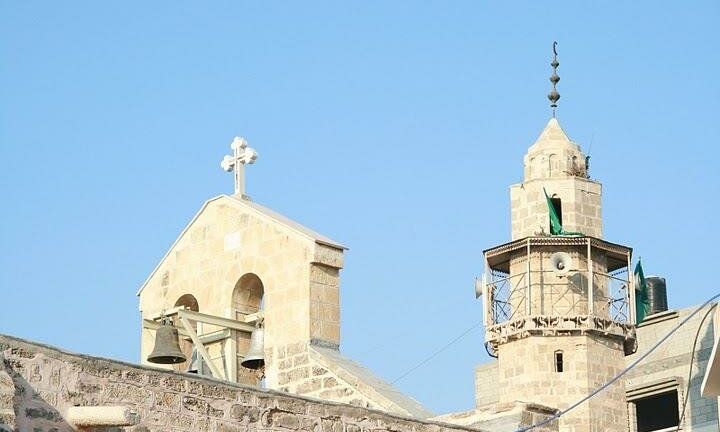The Church of St Porphyrius was struck by an Israeli missile for the second time in a year
© IWAN
Gaza’s Saint Porphyrius church has narrowly escaped destruction for a second time after being struck by an Israeli missile that did not detonate. Believed to be the third-oldest church in the world, the compound was struck last week (on 29 July), nearly ten months after it was first attacked, leaving three people wounded.
“At nine o’clock in the evening, we heard a strong strike in the building where we live inside the church,” Emad Wafa El-Sayegh, the chairman of the board of directors of Gaza’s Young Men’s Christian Association and a displaced resident of the church, tells The Art Newspaper. The shell had struck where El-Sayegh’s children and seven others slept, damaging the ceiling, an adjacent wall, and then falling to the ground floor.
Images of the destruction at Saint Porphyrius Church
Courtesy of Emad Wafa El-Sayegh
Fortunately, his children were elsewhere in the compound at the time of impact, helping other residents. One person was seriously injured and required surgery, while two others sustained minor injuries, according to El-Sayegh. A post on the church’s Facebook page confirmed three injuries and no fatalities.
The father of four expressed gratitude for their survival, noting that if the missile had exploded, it could have destroyed an area of more than 150 sq. m. “The situation was very difficult, and it was God’s power that protected us. We thank God for that,” he says.
The World Council of Churches (WCC), of which Saint Porphyrius is a member, issued a statement on its website condemning the attack.
Reverend professor Jerry Pillay, WCC general secretary, tells The Art Newspaper, “The WCC has condemned attacks on churches, religious sites, hospitals, schools, and places where civilians are based.”
WCC says it maintains close contact with “brother and sisters present at the compound”, and Pillay was scheduled to visit Gaza this week with two Christian humanitarian organisations, ACT Alliance and Caritas Internationalis. However, in light of the “current situation” the trip has been postponed.
“As the WCC, we call for all parties to both end this war and to then reflect further ahead, on how to enable people to live together peacefully in this land,” Pillay says. “The WCC will continue to pray and work for peace in Gaza, in the Holy Land and in the rest of the world,” he adds.
Saint Porphyrius church was first damaged when struck by a missile on 19 October 2023, which killed at least 18 people.
The church is an important site for Christians in the Gaza Strip, who make up an estimated 1,000 people—most of them Greek Orthodox—of the enclave’s total population of 2.3 million. Saint Porphyrius, dating back to AD407, was converted into a mosque in the seventh century. A new church was built in the 12th century by crusaders. It was last renovated in 1856, and today only a few cornices and bases remain from the crusader period.
The church is located in the north of the Gaza Strip, in the Old City’s Zaytun Quarter, an area that has endured some of the war’s most intense bombardments. El-Sayegh and his family, like many others, took shelter inside the church on 9 October and have remained there despite being advised to relocate to southern Gaza. “It is one of the oldest churches in the world. How can we leave it?” he says.
Israeli forces have cut off northern Gaza from the rest of the Strip, resulting in limited food availability. “Vegetables, meat, dairy, cheese, and eggs are prevented from entering northern Gaza. They only allow canned food,” El-Sayegh says, adding that canned food is the primary source of nourishment for the around 250 people sheltering at the church. He also emphasises the difficulty of obtaining medical treatment, which can be life-threatening. El-Sayegh’s elderly mother, who was also at the church, died a week before the strike from a urinary tract infection that had affected her kidney.
Unesco stopped short of condemning the attack, with a spokesperson telling The Art Newspaper that it “remains extremely concerned about the situation in Gaza for the cultural heritage and reiterates all actors’ obligations to adhere strictly to international law”. The spokesperson adds, “Unesco recalls that cultural property should not be targeted or used for military purposes, as it is considered as civilian infrastructure.”
Unesco’s preliminary damage assessment, primarily based on satellite data, included the church on its list of sites that had sustained damage before this latest attack.
More than 39,000 Gazans have been killed since the start of the conflict, says the local health ministry, while most of Gaza’s population have been driven from their homes. More than 1,200 Israelis were killed in the attack on 7 October 2023, according to Israeli tallies, and 253 taken hostage.
“I am sending a message to the free world and I say to them, what are you doing to stop this war and these crimes?” asks a frustrated El-Sayegh.
Despite losing his home and his factory to bombardments and being hit twice at his shelter, El-Sayegh says his community remain unafraid of further attacks, adding “everything is in the hands of God.”

